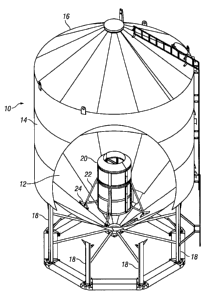Some of the information on this Web page has been provided by external sources. The Government of Canada is not responsible for the accuracy, reliability or currency of the information supplied by external sources. Users wishing to rely upon this information should consult directly with the source of the information. Content provided by external sources is not subject to official languages, privacy and accessibility requirements.
Any discrepancies in the text and image of the Claims and Abstract are due to differing posting times. Text of the Claims and Abstract are posted:
| (12) Patent: | (11) CA 2744311 |
|---|---|
| (54) English Title: | MODULAR AERATION ASSEMBLY FOR GRAIN BINS |
| (54) French Title: | DISPOSITIF D'AERATION MODULAIRE POUR CELLULES A GRAINS |
| Status: | Granted |
| (51) International Patent Classification (IPC): |
|
|---|---|
| (72) Inventors : |
|
| (73) Owners : |
|
| (71) Applicants : |
|
| (74) Agent: | PERRY + CURRIER |
| (74) Associate agent: | |
| (45) Issued: | 2013-12-03 |
| (22) Filed Date: | 2011-06-23 |
| (41) Open to Public Inspection: | 2012-02-26 |
| Examination requested: | 2011-06-23 |
| Availability of licence: | N/A |
| (25) Language of filing: | English |
| Patent Cooperation Treaty (PCT): | No |
|---|
| (30) Application Priority Data: | ||||||
|---|---|---|---|---|---|---|
|
A grain aeration assembly is provided for a hopper bottom bin, and includes a plurality of curved wall segments sized to pass through the manhole of the bin. The wall segments are assembled inside the bin to form a cylindrical tower extending upwardly. The wall segments include an internal frame and inner and outer screens. The tower is supported above the sloped floor of the bin by a plurality of legs. An air conduit extends between the tower and an exterior fan, which provides forced air into the space between the inner and outer screens of the wall segments. The air flows outwardly through the screens, while grain or stored material is prevented from passing through the screens into the wall segments.
Ensemble d'aération pour les grains doté d'une cellule à fond conique et comprenant plusieurs segments latéraux incurvés taillés pour pouvoir passer à travers le trou d'homme de la cellule. Les segments latéraux sont assemblés à l'intérieur de la cellule pour former une tour cylindrique s'allongeant vers le haut. Les segments latéraux comprennent un cadre interne ainsi que des filtres internes et externes. La tour est soutenue au-dessus du plancher incliné de la cellule par plusieurs pattes. Un conduit d'air s'allonge entre la tour et un ventilateur extérieur, qui achemine un air forcé dans l'espace situé entre les filtres internes et externes des segments latéraux. L'air s'écoule vers l'extérieur à travers les filtres, mais aucun grain ni matériel stocké ne peut passer à travers les filtres des segments latéraux.
Note: Claims are shown in the official language in which they were submitted.
Note: Descriptions are shown in the official language in which they were submitted.

For a clearer understanding of the status of the application/patent presented on this page, the site Disclaimer , as well as the definitions for Patent , Administrative Status , Maintenance Fee and Payment History should be consulted.
| Title | Date |
|---|---|
| Forecasted Issue Date | 2013-12-03 |
| (22) Filed | 2011-06-23 |
| Examination Requested | 2011-06-23 |
| (41) Open to Public Inspection | 2012-02-26 |
| (45) Issued | 2013-12-03 |
There is no abandonment history.
Last Payment of $347.00 was received on 2024-03-18
Upcoming maintenance fee amounts
| Description | Date | Amount |
|---|---|---|
| Next Payment if standard fee | 2025-06-23 | $347.00 |
| Next Payment if small entity fee | 2025-06-23 | $125.00 |
Note : If the full payment has not been received on or before the date indicated, a further fee may be required which may be one of the following
Patent fees are adjusted on the 1st of January every year. The amounts above are the current amounts if received by December 31 of the current year.
Please refer to the CIPO
Patent Fees
web page to see all current fee amounts.
| Fee Type | Anniversary Year | Due Date | Amount Paid | Paid Date |
|---|---|---|---|---|
| Request for Examination | $800.00 | 2011-06-23 | ||
| Application Fee | $400.00 | 2011-06-23 | ||
| Maintenance Fee - Application - New Act | 2 | 2013-06-25 | $100.00 | 2013-06-21 |
| Final Fee | $300.00 | 2013-09-19 | ||
| Maintenance Fee - Patent - New Act | 3 | 2014-06-23 | $300.00 | 2014-06-24 |
| Maintenance Fee - Patent - New Act | 4 | 2015-06-23 | $100.00 | 2014-06-24 |
| Maintenance Fee - Patent - New Act | 5 | 2016-06-23 | $200.00 | 2016-06-01 |
| Maintenance Fee - Patent - New Act | 6 | 2017-06-23 | $200.00 | 2017-05-31 |
| Maintenance Fee - Patent - New Act | 7 | 2018-06-26 | $200.00 | 2018-05-31 |
| Maintenance Fee - Patent - New Act | 8 | 2019-06-25 | $200.00 | 2019-05-29 |
| Maintenance Fee - Patent - New Act | 9 | 2020-06-23 | $200.00 | 2020-06-03 |
| Maintenance Fee - Patent - New Act | 10 | 2021-06-23 | $255.00 | 2021-06-02 |
| Maintenance Fee - Patent - New Act | 11 | 2022-06-23 | $254.49 | 2022-05-05 |
| Maintenance Fee - Patent - New Act | 12 | 2023-06-23 | $263.14 | 2023-03-24 |
| Maintenance Fee - Patent - New Act | 13 | 2024-06-25 | $347.00 | 2024-03-18 |
Note: Records showing the ownership history in alphabetical order.
| Current Owners on Record |
|---|
| WOODHAVEN CAPITAL CORP. |
| Past Owners on Record |
|---|
| None |